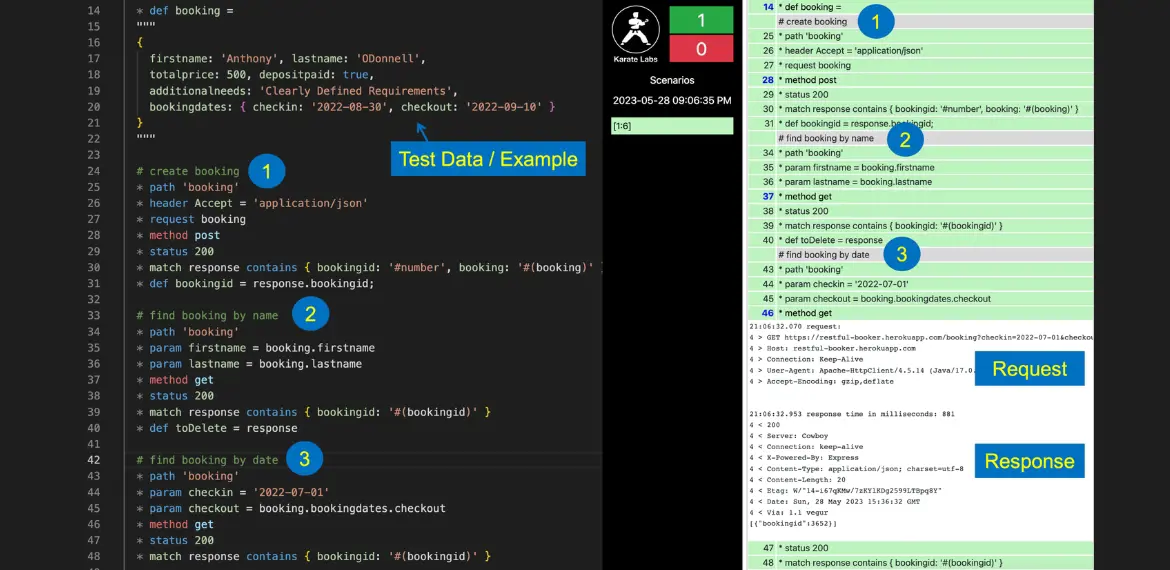Looking For An Alternative To Postman? Discover New API Testing Solutions

The landscape of API testing is evolving, and it is essential to adapt to these changes for efficient and cost-effective testing solutions. Karate API testing is becoming the top priority for developers due to the Karate framework and tutorials.
This blog will focus on why code-based open-source tools are gaining prominence in automated API system testing compared to GUI-based tools like Postman or Insomnia. We will look at the advantages of code-based testing tools, emphasizing their superior maintainability and seamless integration into existing development infrastructures.
As the demands for API testing continue to grow, we will also help you with recommendations on which tools to consider for your specific technology stack. So, if you want to optimize your API testing practices while keeping costs in check, read the blog to discover the most suitable an alternative to the Postman.
Code-Based Open Source API Testing Tools
If we talk about API system testing, code-based open-source tools are becoming more popular. These tools help users to develop and execute test scripts using programming languages like Java, Python, and JavaScript. Some noteworthy examples in this category include REST-Assured, Karate, supertest, and PyTest.
Code-based open-source tools offer several advantages:
- With the ability to code your tests, you have unparalleled flexibility in crafting complex scenarios and testing edge cases.
- You can customize your test scripts to fulfill the specific needs of your API, enabling precise testing and validation.
- These tools seamlessly integrate into your development workflow, allowing continuous testing and automation.
- Test scripts can be version-controlled, ensuring traceability and collaboration among team members.
In the rapidly evolving world of API testing, code-based open-source tools have become the pillar for those seeking reliable, scalable, and cost-effective solutions.
GUI vs. CLI for Exploratory API Testing
Regarding exploratory API testing, the choice between GUI (Graphical User Interface) and CLI (Command Line Interface) tools like Postman or Insomnia is crucial. GUI-based tools provide a user-friendly point-and-click interface for creating and executing test requests. These tools are known for their ease of use and are favored by developers and testers for quick exploratory testing.
Key features of GUI-based tools include:
- Support for Authentication: GUI tools offer various authentication methods for secure API testing.
- Collection Management: You can organize and manage collections of requests efficiently.
- API Documentation: Many GUI tools provide built-in support for API documentation, aiding in better test design.
- Extensibility: These tools offer various integrations and plugins for extending functionality.
On the other hand, CLI tools, often used in tandem with code-based testing, provide the advantage of automation and scripting. They are preferred when repetitive testing or complex scenarios are involved.
The choice between GUI and CLI depends on your testing objectives, preference for user interface, and the nature of your testing requirements.
License Comparison: Postman vs. Insomnia
Understanding the licensing models of API testing tools like Postman and Insomnia is essential for making an informed choice.
Insomnia: Insomnia is an open-source, cross-platform API client that is free to use and modify. It appeals to users who seek the freedom to customize their testing environment. Insomnia also offers a paid plan with additional features and support, catering to more advanced needs.
Postman: Postman is a commercial API platform that provides a free plan for individual users and small teams. For larger teams and enterprises, Postman offers paid plans. Additionally, there are various alternatives, such as Paw and plugins for popular code editors like VSCode and IntelliJ.
Advantages of Code-Based Automation in API Testing
Below are some of the key advantages of code-based automation in API testing. You can analyze them in order to make informed decisions.
Integration
Code-based open-source tools seamlessly integrate with a range of tools and systems, including version control, reporting, and more. This integration capability would do wonders in the stage of automation and collaboration in the testing process. While GUI-based tools like Postman or Insomnia offer some extensibility features, they are not as comprehensive or customizable as their code-based counterparts. Integrating code-based tools into your existing development ecosystem ensures a cohesive and efficient testing workflow.
Reduction in Cost
These tools help in saving a significant portion of the cost. They are free and open-source, which makes them more accessible to developers without purchasing subscriptions or licenses. This cost-effectiveness can save users money and time, eliminating concerns about expensive paid plans or licensing changes that may impact budget issues. Along with that, code-based tools help developers maintain their testing infrastructure independently, which further helps them reduce long-term costs associated with proprietary solutions. This is especially important if you are considering the longevity of test code that can sometimes outlast the productive code, holding essential domain knowledge in the form of tests.
Maintainability
Using these tools offers superior maintainability in automated API system testing. With the ability to write test scripts using a programming language, users gain more control and flexibility over the test logic and flow. This flexibility simplifies maintaining and updating test scripts as APIs evolve or change. On the other hand, GUI-based tools like Postman or Insomnia, relying on graphical interfaces, can be cumbersome and error-prone when dealing with complex or dynamic situations. Also, code-based open-source tools can leverage the existing frameworks and libraries, which makes them reusable and modular code components that enhance the readability and maintainability of test scripts.
Code-Based Automation Benefits: More Insights
As teams transition from GUI-based tools like Postman to code-based automation solutions, they often discover additional advantages that significantly enhance their testing processes. Some of these benefits include:
IDE Integration:
Postman lacks IDE integration, which needs developers to work in a different environment for test development than their regular coding workflows. With different code-based tools, developers can write and manage tests within their familiar IDEs, streamlining the development process and reducing context-switching.
GitHub Integration:
Collaboration and version control are essential in modern software development. Postman's lack of GitHub integration can hinder effective code reviews, pull requests (PRs), and collaboration within development teams. On the contrary, code-based automation tools effortlessly integrate with GitHub and other version control systems, which would ensure a smooth workflow for collaborative testing and code review procedures.
Compliance with Company Policies:
Storing API test collections externally in the cloud may not align with some company policies due to security and compliance concerns. Code-based solutions resolve this issue by enabling teams to share code within repositories, offering transparency and compliance with corporate policies.
Top Alternatives for Automated System Testing
For automated system testing against the API layer, choosing the tool that best fits your technology stack is crucial. Here are some top code-based open-source recommendations for different technology stacks:
Java
- Karate: A powerful API testing framework that combines API test automation, mocks, and performance testing into one tool.
- RestAssured: A Java library that simplifies API testing by providing a natural syntax and a wide range of features.
Python
- Pytest Test Framework: A popular Python testing framework that offers flexibility and extensibility for API testing.
- Requests HTTP Client Library: A Python library for making HTTP requests and handling API interactions.
ABAP
- For ABAP, you can either leverage one of the above tools tailored to specific programming languages or consider writing system tests using the ABAP unit, depending on your unique requirements.
JavaScript
- Mocha or Jest NodeJS Test Frameworks: These JavaScript test frameworks are versatile and suitable for API testing, offering robust testing capabilities.
- Supertest HTTP Client Library: A popular library for making HTTP requests and assertions in JavaScript, ideal for API testing.
How can karate API testing help?
Karate API testing is a robust solution for improving developers' API testing efforts. Whether you are thinking of streamlining your testing workflow, improving test script maintainability, or harnessing the full potential of open-source testing tools, Karate has you covered. Here's how Karate API testing can benefit your testing process:
- Simplified Test Scripting: Karate's unique DSL (Domain-Specific Language) simplifies test script creation. With a clear and intuitive syntax, writing test cases becomes straightforward, reducing the learning curve for beginners and increasing productivity for experienced testers.
- Built-In Features: Karate offers a wide range of built-in features for API testing, including data-driven testing, parallel execution, and detailed test reports. These features empower you to design comprehensive test suites that cover various scenarios and edge cases.
- Integration-Friendly: Karate seamlessly integrates with popular tools like Jenkins and Git, making it an excellent choice for CI/CD pipelines. This integration ensures that your API tests are automatically targeted and included in your continuous testing process.
- Reusable Code: Karate encourages reusable code, allowing you to modularize your test scripts. This approach enhances maintainability, as changes to APIs or endpoints can be addressed in one central location, reducing script update efforts.
- Active Community: Karate boasts an active and supportive community of testers and developers. You can find helpful resources, documentation, and answers to your questions within the Karate community.
Wrapping Up
The digital space is constantly changing with the evolution of new technologies and solutions. This blog has covered all the alternatives for API testing solutions to empower you and your team with a better range of solutions. With Karate API testing and Karate framework tutorial, you gain a versatile and reliable tool that simplifies test scripting, enhances maintainability, and seamlessly integrates into your development pipeline.
Our team has developed this platform to empower testers and developers worldwide to achieve their testing goals. Our Karate frameworks help developers complete their UI testing precisely. Our commitment to the open-source community ensures we remain a top choice for API testing.
So, are you ready to take your API testing to the next level? Join the growing community of Karate users and experience the benefits firsthand.






